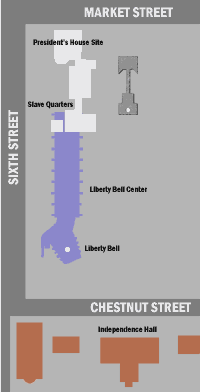Overview of the Controversy About the President's House in Philadelphia

"In January 1952 an important find was made on the block opposite Independence Hall in Philadelphia. Dozens of 19th-century buildings had just been demolished to make way for the creation of Independence Mall, and large piles of rubble remained. David H. Morgan, an architect and amateur historian, dug through the rubble and uncovered the foundations of the President's House — the Executive Mansion of the United States from 1790 to 1800 — the residence of George Washington and John Adams during Philadelphia's tenure as the national capital.
"The local chapter of the American Institute of Architects (AIA) requested an immediate halt to further demolition of the site, but the request was denied. The Philadelphia Inquirer published a story under the headline 'Bulldozers Trample Site Where Washington Slept' [1952], but the foundations were reburied. The AIA urged that a footprint of the President's House be incorporated into the Mall's design, but they were ignored. A visitor will find a public bathroom exactly where the President's House once stood." [The bathroom was removed on May 27, 2003.]
So wrote historian Edward Lawler, Jr., in 2002.Proper recognition of the President's House in Philadelphia has been at issue periodically throughout the 19th and 20th centuries. In the mid-1990s, during the public meetings on the redesign of Independence Mall, there were calls to commemorate the house.
In August, 2001, the Independence Hall Association (owners of ushistory.org) wrote to the superintendent of Independence National Historical Park requesting that the President's House be appropriately commemorated by marking the paving. The request was refused, stating, "Placing the stone outline in the foyer of the Liberty Bell Center will create a design dissonance between the two features, potentially causing confusion for visitors."
In January 2002, The Pennsylvania Magazine of History and Biography published Edward Lawler Jr.'s comprehensive and authoritative "The President's House in Philadelphia: The Rediscovery of a Lost Landmark," which focused national attention on the issue of the house and the enslaved men and women who toiled in the house when Washington was president.
On March 13, Gary Nash, Professor of History at the University of California, Los Angeles, in a radio interview on WHYY said, "We have one of the most important historical sites in Philadelphia which is being graded over and everything beneath it is being buried and lost for all succeeding generations. And this is the house that George Washington and John Adams used as their executive mansion when they were the President of the United States here in the 1790s. It was the Robert Morris House, and that's exactly where the Liberty Bell will find its new home. And millions of visitors are going to go into the Liberty Bell not knowing they are walking over the site of Washington's executive mansion, indeed walking over the slave quarters he built at the rear of the house.... We have here a conjunction of liberty and slavery on the same site!"
On March 24, Stephan Salisbury and Inga Saffron of The Philadelphia Inquirer published a piece titled, "Echoes of slavery at Liberty Bell site." The controversy burst into the public discourse. Philadelphia Mayor John Street called for a meeting with the Park Service.
Edward Robinson Jr., an author and educator, said, "We want to memorialize the fact that our ancestors in and around Sixth and Chestnut were brought there, forced there by a white man, George Washington. He bought them, body and soul, and we want to memorialize them, not just as our ancestors, but as people."
Charles Blockson, curator of the Charles Blockson Afro-American Collection at Temple University, said, "We need a memorial there. Why not a memorial? A memorial to enslaved ancestors means more to me than the Liberty Bell."
Attorney Michael Coard, an organizer of the Avenging the Ancestors Coalition said, "We want a monument, a memorial, a bold, serious structure that people can see and touch, just like they touch the Liberty Bell."
Public debate about if and how to interpret the site was conducted in the newspapers, radio, and internet, as well as on the streets of Philadelphia, throughout 2002.
In January 2003, in response to a Congressional mandate, the Park Service unveiled their preliminary designs at a meeting filled with accusations and friction. The Independence Hall Association wrote to members of Congress supporting the basic design, but also noted problems such as the erasure of the slave quarters [Read letter.]. In May 2003, INHP claimed there had been no slave quarters, and Lawler responded.




